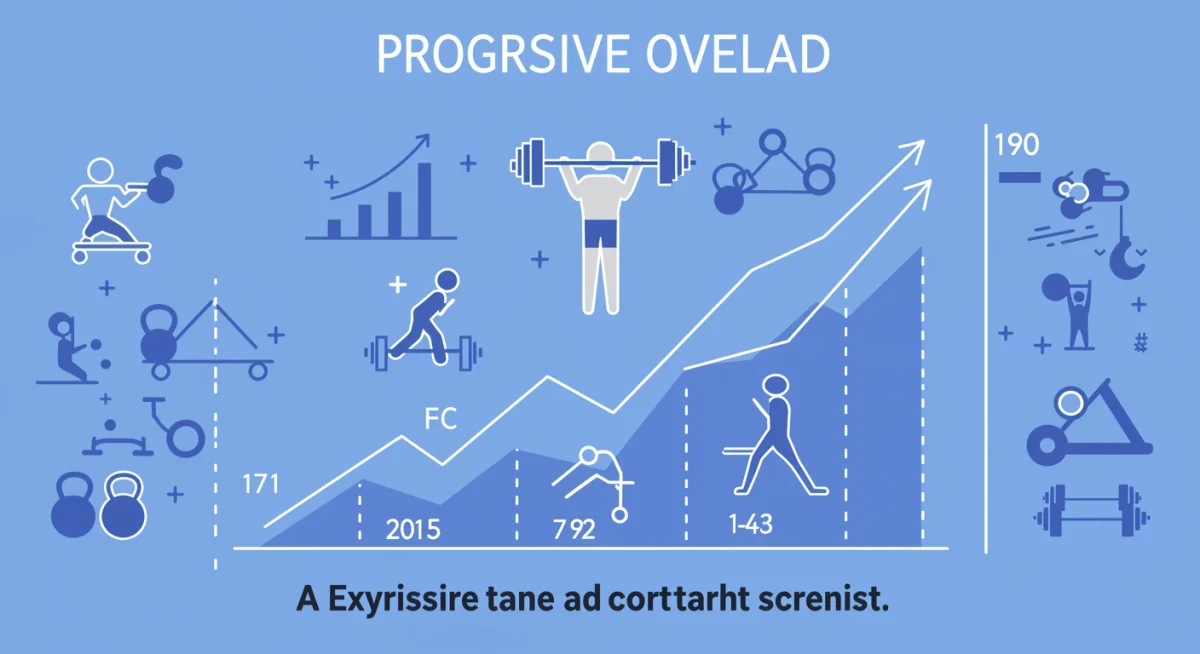Prevent Fitness Plateaus 2025: Insider’s Guide to Consistent Progress

Preventing fitness plateaus in 2025 requires strategic adjustments to training, nutrition, and mindset, ensuring continuous progress and sustained motivation in your fitness journey.
Are you ready to make 2025 your year for unwavering fitness progress? Many individuals hit a wall, experiencing what’s known as a fitness plateau, where their hard work no longer yields the desired results. This Insider’s Guide to Preventing 3 Common Fitness Routine Plateaus in 2025: Actionable Steps for Consistent Progress is designed to equip you with the knowledge and strategies to navigate and overcome these frustrating hurdles, ensuring your dedication translates into continuous improvement.
Understanding the Plateau Phenomenon: Why Progress Stalls
The journey to peak physical condition is rarely a straight line; more often, it resembles a series of peaks and valleys. When you first start a new fitness routine, gains often come quickly, fueled by novelty and your body’s initial adaptation. However, as your body becomes accustomed to the demands placed upon it, progress can inexplicably slow down or even halt altogether. This is the essence of a fitness plateau, a common, yet often frustrating, experience for many.
It’s crucial to understand that a plateau isn’t a sign of failure but rather an indication that your body has adapted to its current stimulus. Your muscles, cardiovascular system, and nervous system have learned to perform the exercises with maximum efficiency, meaning they no longer need to work as hard to achieve the same output. This efficiency, while beneficial in some contexts, becomes a barrier to further growth and development. Recognizing this as a natural part of the fitness cycle is the first step toward effective prevention and intervention.
The Science Behind Adaptation
Our bodies are incredibly adaptive machines. When subjected to stress, such as exercise, they respond by becoming stronger, faster, or more enduring to better handle future stressors. This principle, known as the SAID principle (Specific Adaptation to Imposed Demands), is fundamental to fitness. However, once the body has fully adapted to a particular demand, that demand no longer serves as a sufficient stimulus for further adaptation. To continue progressing, the stimulus must change.
- Neuromuscular Efficiency: Your brain and muscles become highly coordinated, performing movements with less effort.
- Metabolic Adaptation: Your body becomes more efficient at using energy for specific activities.
- Muscle Fiber Recruitment: Optimal muscle fibers are recruited for the task, reducing the need for new growth.
Ignoring these signs and continuing with the same routine often leads to stagnation, demotivation, and even an increased risk of injury due to repetitive strain. Therefore, understanding the underlying mechanisms of adaptation is key to proactively preventing plateaus and maintaining consistent progress.
Plateau 1: Stagnant Strength and Muscle Growth
One of the most common and disheartening plateaus occurs when your strength gains halt, and muscle growth seems to cease. You’re lifting the same weights, performing the same reps, and seeing no change in your physique or performance. This specific plateau often stems from a lack of progressive overload, insufficient recovery, or suboptimal nutrition.
To break through this, a multi-faceted approach is necessary, focusing on continually challenging your muscles in new ways, ensuring adequate rest, and fueling your body correctly. It’s not just about lifting heavier; it’s about smarter training and comprehensive self-care.
Implementing Progressive Overload Effectively
Progressive overload is the cornerstone of continuous strength and muscle growth. It means gradually increasing the stress placed on your body during exercise. If you’re not consistently challenging your muscles, they have no reason to grow stronger or larger. This doesn’t solely mean adding more weight; it encompasses various strategies:
- Increase Weight: The most straightforward method, but not always feasible or safe.
- Increase Repetitions: Performing more reps with the same weight.
- Increase Sets: Adding more sets to your workout.
- Decrease Rest Times: Reducing the time between sets to increase intensity.
- Improve Form: Executing the exercise with perfect technique, making it more effective.
- Increase Time Under Tension: Slowing down the movement to keep muscles engaged longer.
- Increase Frequency: Training a muscle group more often.
Varying your approach to progressive overload keeps your muscles guessing and prevents them from fully adapting. For instance, cycling through periods of higher weight/lower reps and lower weight/higher reps can stimulate different muscle fibers and promote overall growth. Consistency in applying these principles is far more important than sporadic, intense bursts.
Optimizing Nutrition and Recovery for Muscle Growth
Training is only one part of the equation; nutrition and recovery are equally vital for overcoming strength and muscle growth plateaus. Your muscles need raw materials to repair and grow, and they need time to do so.
Ensure you are consuming enough protein to support muscle repair and synthesis, typically around 0.7-1 gram per pound of body weight. Carbohydrates are essential for energy during workouts and replenishing glycogen stores afterward, while healthy fats support hormone production. Adequate sleep (7-9 hours) is non-negotiable, as this is when the majority of muscle repair and growth occurs. Incorporate active recovery days, stretching, and foam rolling to improve blood flow and reduce muscle soreness.
Plateau 2: Stalled Weight Loss or Body Composition Changes
Many individuals embark on a fitness journey with the primary goal of weight loss or improving body composition. It can be incredibly frustrating when the scale stops moving, or your body measurements remain unchanged, despite consistent effort. This plateau often arises from metabolic adaptation, insufficient calorie deficit, or neglecting the role of non-exercise activity thermogenesis (NEAT).
Your body is incredibly efficient at adapting to calorie restriction and increased activity. To break through this, you need to outsmart your body’s adaptive mechanisms by strategically adjusting your caloric intake, macronutrient ratios, and overall activity levels, not just your structured workouts.
Re-evaluating Caloric Intake and Macronutrient Balance
When weight loss stalls, the first step is often to meticulously re-evaluate your caloric intake. Your metabolic rate can decrease as you lose weight, meaning the calorie deficit that initially worked may no longer be sufficient. Consider a slight reduction in calories (e.g., 100-200 calories per day) or implement calorie cycling, where you vary your caloric intake on different days of the week.
Macronutrient balance also plays a critical role. Ensure you’re getting enough protein to preserve muscle mass during a deficit, as muscle is metabolically active and helps burn more calories. Carbohydrates provide energy, and healthy fats are crucial for satiety and hormone function. Avoid drastic cuts to any single macronutrient, as this can lead to nutrient deficiencies and rebound weight gain.

Boosting Non-Exercise Activity Thermogenesis (NEAT)
While structured workouts are important, your NEAT—the energy expended for everything we do that is not sleeping, eating, or sports-like exercise—can significantly impact your daily calorie burn. As you become fitter, you might unconsciously move less outside of your workouts, or your body becomes more efficient at performing daily tasks, reducing NEAT.
- Take the stairs instead of the elevator.
- Walk or bike for short commutes.
- Stand more often at work.
- Incorporate short walking breaks throughout the day.
- Do household chores with more intensity.
Small, consistent increases in NEAT can add up to a substantial caloric expenditure over time, helping to reignite weight loss or improve body composition without adding more structured workout time. Tracking your daily steps with a fitness tracker can be a simple yet effective way to monitor and increase your NEAT.
Plateau 3: Decreased Endurance and Cardiovascular Performance
For those focused on cardiovascular fitness, a plateau can manifest as a stagnation in running speed, cycling distance, or overall endurance. You might find yourself unable to run faster, go longer, or recover as quickly as you once did. This type of plateau often comes from a lack of varied training stimuli, insufficient recovery from high-intensity work, or neglecting the importance of efficient movement patterns.
To overcome this, you need to introduce new challenges to your cardiovascular system, allowing for both adaptation and adequate rest. This means moving beyond steady-state cardio and incorporating different training methodologies to improve various aspects of your endurance.
Incorporating Interval Training and Varied Workouts
If your cardio routine primarily consists of steady-state exercise, your body has likely become highly efficient at it. To improve endurance and cardiovascular performance, you need to introduce different types of stress. High-Intensity Interval Training (HIIT) is particularly effective for this.
HIIT involves short bursts of intense exercise followed by brief recovery periods. This challenges your anaerobic system and significantly improves your VO2 max (the maximum amount of oxygen your body can use during intense exercise). Besides HIIT, consider:
- Tempo Runs: Sustained efforts at a challenging but manageable pace.
- Fartlek Training: Unstructured speed play, varying pace and intensity as you feel.
- Cross-Training: Engaging in different activities like swimming, cycling, or rowing to work different muscle groups and reduce impact.
- Hill Repeats: Running or cycling uphill to build strength and cardiovascular power.
Varying your workouts prevents your body from fully adapting to one type of stimulus, continually pushing your cardiovascular system to improve its capacity and efficiency.
Prioritizing Recovery and Movement Efficiency
Just like with strength training, recovery is paramount for endurance athletes. Overtraining can lead to decreased performance, increased injury risk, and chronic fatigue. Ensure you’re incorporating rest days, active recovery (light walks, stretching), and sufficient sleep into your routine. Proper hydration and electrolyte balance are also critical for optimal cardiovascular function.
Furthermore, focus on movement efficiency. For runners, this means working on stride mechanics; for cyclists, pedal stroke efficiency. Even small improvements in form can lead to significant gains in performance with less energy expenditure. Consider professional coaching or video analysis to identify and correct inefficiencies in your movement patterns. Addressing both training and recovery holistically will ensure consistent progress in your cardiovascular endeavors.
The Mental Game: Sustaining Motivation Through Plateaus
Fitness plateaus are not just physical; they can be profoundly mental. The frustration of seeing no progress can quickly erode motivation, leading many to abandon their fitness goals altogether. Understanding and addressing the psychological aspect of plateaus is just as important as the physical strategies.
Maintaining a positive mindset, setting realistic expectations, and celebrating small victories are crucial for navigating these challenging periods. Your mental resilience will often determine whether you break through a plateau or succumb to it.
Resetting Goals and Celebrating Small Wins
When you hit a plateau, it’s an opportune time to reassess your goals. Perhaps your initial goals were too ambitious, or you’ve achieved them and need new ones. Instead of focusing solely on the big picture, break down your larger objectives into smaller, achievable milestones. For example, instead of ‘lose 20 pounds,’ aim for ‘lose 2 pounds this month’ or ‘add 5 pounds to my squat’s working weight.’
- Set SMART goals: Specific, Measurable, Achievable, Relevant, Time-bound.
- Track non-scale victories: Improved sleep, increased energy, better mood, clothes fitting differently.
- Reward yourself: Non-food rewards for reaching milestones, like new workout gear or a massage.
Celebrating these smaller wins provides regular boosts of motivation and reinforces positive behavior, making the journey feel less daunting and more rewarding, even when major progress is slow.
The Power of Variety and Cross-Training
Monotony is a significant motivation killer. Performing the same exercises day in and day out can lead to boredom and a lack of enthusiasm. Introducing variety into your routine isn’t just physically beneficial for preventing plateaus; it’s also a powerful psychological tool.
Cross-training, which involves incorporating different types of exercise into your routine, can reignite your passion. If you primarily lift weights, try a dance class or swimming. If you’re a runner, explore hiking or cycling. New activities challenge your body in different ways, engage new muscle groups, and prevent mental burnout. This fresh perspective can make your fitness journey exciting again, helping you power through any motivational dip that a plateau might cause.
Advanced Strategies for Breaking Through Stubborn Plateaus
Sometimes, despite implementing the fundamental strategies, a plateau can be particularly stubborn. This is when advanced techniques and a deeper understanding of your body become necessary. These strategies often involve more precise adjustments to your training, nutrition, and lifestyle, requiring a greater degree of commitment and self-awareness.
Don’t be discouraged if basic changes aren’t yielding immediate results; think of it as an opportunity to fine-tune your approach and learn more about what truly works for your unique physiology. Persistence and a willingness to experiment are key.
Deload Weeks and Periodization
One often-overlooked strategy for breaking plateaus is incorporating deload weeks into your training cycle. A deload week involves significantly reducing the volume and/or intensity of your workouts for a short period (typically one week). This allows your body to fully recover, repair, and adapt to the previous weeks of intense training, preventing overtraining and promoting supercompensation.
Periodization takes this concept further, structuring your training into distinct phases, each with specific goals (e.g., hypertrophy, strength, power, endurance). By systematically varying training variables over time, periodization prevents adaptation plateaus and optimizes long-term progress. Consult with a qualified coach to design a periodized program tailored to your goals.

Hormonal Balance and Stress Management
Beyond training and nutrition, hormonal balance and stress management play a significant role in your body’s ability to progress. Chronic stress elevates cortisol levels, which can hinder muscle growth, promote fat storage, and impair recovery. Similarly, imbalances in other hormones, such as testosterone, estrogen, or thyroid hormones, can severely impact your fitness results.
Prioritize stress-reducing activities like meditation, yoga, spending time in nature, or engaging in hobbies. Ensure you’re getting enough quality sleep, as mentioned before, as it’s crucial for hormonal regulation. If you suspect a hormonal imbalance, consult a healthcare professional. Addressing these underlying physiological factors can often be the missing piece in breaking through a persistent plateau, allowing your body to respond more effectively to your training efforts.
The Importance of Consistency and Patience
In the pursuit of fitness, it’s easy to get caught up in the desire for immediate results. However, true and lasting progress is a marathon, not a sprint. The most successful fitness journeys are characterized by unwavering consistency and profound patience. Understanding that plateaus are a natural, albeit frustrating, part of the process is crucial for long-term success.
Every plateau offers an opportunity for learning and adaptation. It forces you to re-evaluate your methods, listen more closely to your body, and become a more intelligent and intuitive athlete. Embrace these challenges as integral steps on your path to optimal health and fitness, knowing that with the right strategies and a resilient mindset, you can always find a way forward.
Remember that your body is a complex system, and what works for one person might not work for another. Be willing to experiment, track your progress diligently, and make informed adjustments. Celebrate every small victory, stay hydrated, prioritize sleep, and fuel your body with nutrient-dense foods. By consistently applying these principles, you’ll not only prevent common fitness plateaus but also cultivate a sustainable and enjoyable fitness lifestyle.
Ultimately, the journey itself—the discipline, the effort, the self-discovery—is as rewarding as the destination. Stay committed, stay curious, and keep pushing your boundaries. The consistent progress you seek in 2025 and beyond is within your reach.
| Key Plateau | Solution Overview |
|---|---|
| Stagnant Strength/Muscle | Implement progressive overload, optimize protein intake, and ensure adequate sleep and recovery for muscle repair. |
| Stalled Weight Loss | Re-evaluate calorie deficit, adjust macronutrient balance, and increase non-exercise activity thermogenesis (NEAT). |
| Decreased Endurance | Incorporate interval training, varied cardio, and prioritize efficient movement patterns and recovery. |
| Motivation Loss | Set small, achievable goals, track non-scale victories, and introduce variety through cross-training to stay engaged. |
Frequently Asked Questions About Fitness Plateaus
A fitness plateau is a period where your progress in a fitness routine, whether it’s strength, weight loss, or endurance, seems to halt despite consistent effort. It’s a natural adaptation by your body to the demands placed upon it, where the current stimulus is no longer sufficient to trigger further improvement.
The duration of a fitness plateau varies greatly among individuals and depends on the specific cause. It can last anywhere from a few weeks to several months. The key is to recognize it early and implement strategic changes to your training, nutrition, or recovery to break through it efficiently.
Absolutely. Suboptimal nutrition, such as insufficient protein intake for muscle repair, an inadequate calorie deficit for weight loss, or lack of essential micronutrients, can significantly contribute to hitting a plateau. Your body needs proper fuel and building blocks to adapt and progress.
Yes, deload weeks are highly beneficial. They allow your body to fully recover from accumulated fatigue, repair muscle tissue, and prevent overtraining. This strategic reduction in intensity and volume can prime your body for renewed progress when you return to your regular training intensity, effectively preventing or breaking plateaus.
Chronic stress elevates cortisol, a hormone that can hinder muscle growth, increase fat storage, and impair recovery. High stress levels can make it much harder for your body to adapt positively to training stimuli, thus contributing to or prolonging a fitness plateau. Effective stress management is crucial for consistent progress.
Conclusion
Navigating the inevitable challenges of a fitness journey requires foresight and strategic action. This insider’s guide has illuminated the path to preventing the three most common fitness routine plateaus in 2025: stagnant strength and muscle growth, stalled weight loss or body composition changes, and decreased endurance and cardiovascular performance. By consistently applying principles of progressive overload, optimizing nutrition and recovery, embracing varied training methods, and maintaining a resilient mindset, you can transform potential roadblocks into stepping stones. Remember that consistency, patience, and a willingness to adapt are your most powerful tools for achieving and sustaining remarkable fitness progress.





